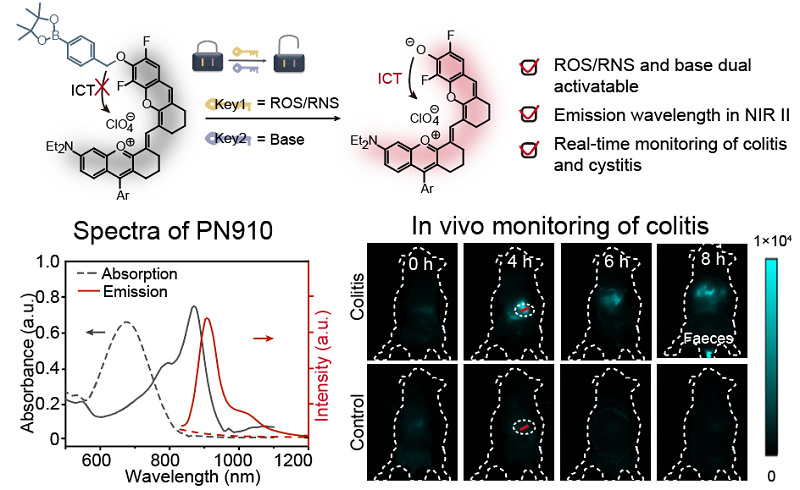
Zuhai Lei's group at the School of Pharmacy and Fan Zhang's group at the Department of Chemistry, Fudan University have made progress in the field of near-infrared II (NIR-II) in vivo fluorescence biosensing. The research project has developed a series of novel NIR-II fluorescent dyes, which can be used for in vivo biosensing in mice by modulating the intramolecular charge transfer (ICT) through hydroxyl modification. The results were published at Angew. Chem. Int. Ed.under the title of ROS/RNS and Base Dual Activatable Merocyanine-Based NIR-II Fluorescent Molecular Probe for in vivo Biosensing. NIR-II fluorescence imaging has been widely used for in vivo deep tissue fluorescence imaging because of its deep penetration depth and weak light scattering. However, most NIR-II fluorescent dyes do not have a fluorescence modulation switch and are always in an always on state, which can only be used for anatomical imaging but not for specific sensing. Therefore, the creation of new NIR-II fluorescent dyes with good stability and fluorescence tunability in NIR-II window would facilitate the rapid development of in vivo specific sensing in small animals, but so far, NIR-II dyes meeting these requirements are still limited. The xanthene dyes and the cyanine dyes have good optical properties and are widely used in biomedical research. The xanthene dyes are bright and stable but have relatively short wavelengths, while the cyanine dyes have long wavelengths but are relatively unstable and not easy to adjust fluorescence. In the previous study (Angew. Chem. Int. Ed., 2019, 58, 8166 - 8171, Angew. Chem. Int. Ed., 2021, 60, 5091-5095), Professor Fan Zhang from the Department of Chemistry and Youth Researcher Zuhai Lei from the School of Pharmacy of Fudan University have created a new method to combine xanthene dyes and cyanine dyes. They developed a series of NIR-II fluorescent dyes, CXs, which can be used for NIR-II fluorescence bioimaging and biosensing.

Figure 1 The design strategy, response mechanism, spectra of the dual activation probe PN910 and in vivo biosensing images.
Recently, Zuhai Lei and Fan Zhang created a new series of NIR-II fluorescent dyes, Chrodol, by replacing the rhodamine-like symmetric structure of CX series dyes with an asymmetric Rhodol-like structure, which has a significant difference in the optical properties of the dyes when the hydroxyl groups are alkylated or in the oxygen-negative state due to their different electron supply capabilities. When the hydroxyl group is alkylated, there is no NIR-II fluorescence emission, while when the hydroxyl group is in the oxygen-negative state, the dye has strong NIR-II fluorescence emission, so that the sensing probe can be constructed by adjusting the intramolecular charge transfer (ICT) properties of the hydroxyl group. After a series of property tests, they selected Chrodol-3, one of the series of dyes, for the construction of the probe. By linking the hydroxyl group of Chrodol-3 to benzyl benzeneborate, the NIR-II molecular probe PN910, which can respond to both basic and ROS/RNS, was obtained. In in vitro tests, PN910 showed excellent pH dependence in response to H2O2 and ONOO-, and in in vivo experiments, PN910 enabled real-time in vivo monitoring of cystitis and enteritis.
In summary, this work realized specific in vivo deep tissue detection of inflammation in alkaline environments by constructing PN910, a probe with dual response to alkalinity and ROS/RNS. In addition, the Chrodol series of dyes can also be used as a platform molecule in the future to enable the detection of a variety of other disease markers through different functionalized modifications.
The first author of the paper is Xin Zhang, a PhD student at Fudan University, and the corresponding authors are Prof. Fan Zhang and Youth Researcher Zuhai Lei.
Link to original article. https://onlinelibrary.wiley.com/doi/10.1002/anie.202109728